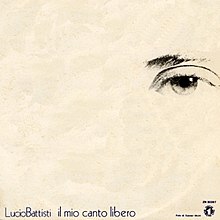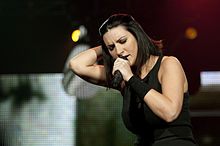| "Il mio canto libero" | ||||
|---|---|---|---|---|
 | ||||
| Single by Lucio Battisti | ||||
| from the album Il mio canto libero | ||||
| B-side | "Confusione" | |||
| Released | November 1972 | |||
| Recorded | Fonorama Studios, Milan | |||
| Genre | Pop | |||
| Length | 5:09 | |||
| Label | Numero Uno | |||
| Songwriter(s) | Lucio Battisti, Mogol | |||
| Producer(s) | Lucio Battisti | |||
| Lucio Battisti singles chronology | ||||
| ||||
| Audio sample | ||||
"Il mio canto libero" (My Free Song) is a song written by Italian singer-songwriter Lucio Battisti and lyricist Mogol. The song was recorded by Battisti for the album of the same title, and released as a single in November 1972 for Mogol's recording label Numero Uno. The song was a commercial success in Italy, topping the Musica e dischi singles chart for nine consecutive weeks in 1973 and becoming the third best-selling single of the year. During the following years, it was covered by several artists, and it became a classic of Italian popular music. It was certified double platinum by the Federation of the Italian Music Industry in 2024, for domestic equivalent sales exceeding 200,000 units since 2009.
The front cover of the single is a photograph by Cesare Monti, showing an eye with a white background.
Background and composition

"Il mio canto libero" was written by Mogol and Battisti, and it was produced by Battisti himself. As revealed by Mogol after Battisti's death, it was initially proposed to Mina, who refused to record the song, because she felt it was not strong enough to become a hit.
The song deals with individual freedom, describing the feelings of a young couple which faces with hope the difficult moment when they have to start living as adults, while feeling a shared sense of alienation within a society they consider hypocritical. During an interview released in 2009 to the Italian newspaper Corriere della Sera, Mogol explained that "The Italian society in that years was very conformist. And there's a couple which rises up against conventions, claiming a right to individual liberty, a right to love." As revealed by Mogol himself, the song was inspired by Mogol's relationship with a young woman after the end of his marriage, and by his feeling that "at that time, the orthodox disapproved that kind of things."
An English-language version of the song, titled "A Song to Feel Alive", with lyrics adapted by Peter Powell, was also recorded by Battisti and included in his album Images, released in 1977. Battisti also recorded the song in Spanish, under the title "Mi libre canción", in French, releasing it as a single in 1973 titled "Ma chanson de liberté", and in German, with lyrics penned by Udo Lindenberg, under the title "Unser freies Lied".
Cover versions

A cover of the song was recorded in 1994 by Italian singer-songwriter Cristiano De André. His version of the song was included in the compilation album Innocenti evasioni, a tribute to Battisti by various Italian artists. On the following year, José Feliciano performed the song during the Italian TV show Mina contro Battisti, a competition between songs originally performed by Mina or Lucio Battisti.
In 2003 the song was covered by the players of the Italian football team Juventus FC as part of a charity project aimed at raising funds to rebuild the San Gerolamo of Quarto Abbey in Genoa, to accommodate the children hospitalised at the Istituto Giannina Gaslini. The song was performed by the team, together with a children choir, during the Sanremo Music Festival 2003.
In 2006, Italian singer Laura Pausini covered the song for her album Io canto, dueting with Colombian recording artist Juanes. Pausini and Juanes recorded the song both in Italian and Spanish. The Italian-language version of the song peaked at number 25 on the FIMI Top Digital Downloads in November 2006. On 21 June 2009, the song was performed by all the artists involved in the mega-concert Amiche per l'Abruzzo, featuring 55 Italian female singers and organized to raise funds in support of the victims of the 2009 L'Aquila earthquake. The song was chosen as the closing performance after an online poll. The live performance was later included in the DVD of the event, released in June 2010.
Spanish singers Rosario Flores and Sergio Dalma recorded "Mi libre canción" for their albums Cuéntame and Via Dalma, in 2009 and 2010, respectively. The original version of the song was also covered by Nathalie during the Sanremo Music Festival 2011. A studio recording of her version was included in the compilation album Nata per unire. Other artists who recorded a cover of the song include Fiorello, who included it in the album A modo mio in 2004, and the band Formula 3.
Track listing
- "Il mio canto libero" – 45 rpm single (Numero Uno ZN 50267) – 1972
- "Il mio canto libero" (Lucio Battisti, Mogol) – 5:09
- "Confusione" (Battisti, Mogol) – 4:29
- "Ma chanson de liberté" – 45 rpm single (Vogue, Numero Uno NU 3047) – 1973
- "Ma chanson de liberté" (Lucio Battisti, Mogol, Eddie Marnay) – 5:07
- "Vento nel vento" (Lucio Battisti, Mogol) – 3:23
- "Mi libre canción" – 45 rpm single (Rca Victor TPBO 9104) – 1973
- "Mi libre canción" (Lucio Battisti, Mogol, Carlos Ràmon Amàrt) – 5:07
- "Io vorrei... non vorrei... ma se vuoi..." (Lucio Battisti, Mogol) – 4:36
Credits and personnel

Production and music credits
- Lucio Battisti – vocals, producer, arranger, acoustic guitar, Hawaiian guitar, drums, background vocals
- Gian Piero Reverberi – arrenger, orchestra conductor
- Massimo Luca – acoustic guitar, electric guitar
- Mario Lavezzi – guitar, drums
- Reginaldo Ettore – drums
- Gabriele Lorenzi – keyboards
- Gigi Mucciolo – trumpet, trombone
- Gianni Dall'Aglio – drums
- Guido Guglielminetti – bass guitar
- "4+4 di Nora Orlandi" – background vocals
Charts
Weekly charts
|
Year-end charts
|
Certifications and sales
| Region | Certification | Certified units/sales |
|---|---|---|
| Italy (FIMI) sales since 2009 |
2× Platinum | 200,000 |
|
Sales+streaming figures based on certification alone. | ||
References
- ^ "Il mio canto libero/Confusione" (in Italian). Discografia Nazionale della Canzone Italiana. Ministry of Cultural Heritage and Activities. Retrieved 4 August 2013.
- ^ Ezio Guaitamacchi (2009). "Lucio Battisti - Il mio canto libero". Mille canzoni che ci hanno cambiato la vita (in Italian). Rizzoli. p. 416. ISBN 9788817033923.
- "Cronologia di: Il mio canto libero di Lucio Battisti". Musica e dischi (in Italian). Retrieved 25 August 2023.
- ^ Robert Dimery (5 December 2011). "Il mio canto libero". 1001 Songs: You Must Hear Before You Die. Hachette UK. pp. 875–876. ISBN 978-1844037179.
- ^ "Italian single certifications – Lucio Battisti – Il mio canto libero" (in Italian). Federazione Industria Musicale Italiana. Retrieved 23 April 2024.
- Severino Colombo (8 September 2007). "Emozioni anche in russo per ricordare Lucio Battisti". Corriere della Sera (in Italian). Retrieved 4 August 2013.
- Jacopo Granzotto (23 February 2009). "Clamoroso: quando Mina rifiutò Il mio canto Libero e Ancora tu". Il Giornale (in Italian). Archived from the original on 4 August 2013. Retrieved 4 August 2013.
- Aldo Cazzullo (28 June 2005). "Mogol: un braccio alzato per dirigere il coro". Corriere della Sera (in Italian). Retrieved 4 August 2013.
- Aldo Cazzullo (15 June 2009). "Mogol: basta ipocrisie sulla canzone di Povia (la migliore dell'anno)". Corriere della Sera (in Italian).
- "Lucio Battisti – Images" (in Italian). Discografia Nazionale della Canzone Italiana. Ministry of Cultural Heritage and Activities. Retrieved 4 August 2013.
- ^ Pippo Augliera (29 May 2013). "Lucio Battisti in edicola: dieci interessanti cd con brani noti e rarità" (in Italian). Musicalnews.com. Archived from the original on 6 August 2013. Retrieved 6 August 2013.
- ^ "Lucio Battisti – Brani" (in Italian). Hitparadeitalia.it. Retrieved 6 August 2013.
- "Innocenti evasioni 2006: tributo a Lucio Battisti con Ligabue e altri" (in Italian). Rockol.it. 19 July 2006. Retrieved 4 August 2013.
- Stefania Ulivi (6 December 1995). "Mina contro Battisti, sfida impossibile tra fantasmi". Corriere della Sera (in Italian). Retrieved 4 August 2013.
- "Il canto libero della Juventus un cd per i bambini del Gaslini". la Repubblica (in Italian). 16 September 2003. Retrieved 4 August 2013.
- "53° Festival della Canzone Italiana". Corriere della Sera (in Italian). Retrieved 4 August 2013.
- "Laura Pausini – Io canto" (in Italian). Rockol.it. 13 December 2006. Retrieved 4 August 2013.
- Ana Asensio (4 December 2006). "Laura Pausini: Un día querré parar y dedicarme a ser madre". ABC (in Spanish). Archived from the original on 4 August 2013. Retrieved 4 August 2013.
- "Top Digital – Classifica settimanale WK 47 (dal 2006-11-20 al 2006-11-26)" (in Italian). Federation of the Italian Music Industry. Archived from the original on 23 November 2016. Retrieved 23 November 2016.
- "A San Siro Amiche per l'Abruzzo". TGCOM (in Italian). Mediaset. 21 June 2009. Retrieved 4 August 2013.
- "Le sorelle d'Abruzzo e i 55mila fan". TGCOM (in Italian). Mediaset. 22 June 2009.
- "Artisti Vari – Amiche per l'Abruzzo" (in Italian). Rockol.it. 22 June 2010. Retrieved 4 August 2013.
- "Sergio Dalma – Via Dalma". Allmusic.com. Retrieved 4 August 2013.
- Mariano Prunes. "Cuéntame – Rosario Flores". Allmusic.com.
- Alessandra Vitali (17 February 2011). "All'Ariston sventola il tricolore. Gli artisti e i brani-nostalgia". la Repubblica (in Italian).
- "Sanremo 2011, esce 'Nata per unire': l'Italia cantata dagli artisti del Festival" (in Italian). Rockol.it. 17 February 2011. Retrieved 4 August 2013.
- "Fiorello – A modo mio" (in Italian). Rockol.it. 30 October 2004. Retrieved 4 August 2013.
- "25 Anni di Lucio Battisti – Formula 3" (in Italian). Allmusic. Retrieved 4 August 2013.
- ^ "Discografie – Lucio Battisti" (in Italian). Hitparadeitalia.it. Archived from the original on 6 August 2013. Retrieved 6 August 2013.
- "Lucio Battisti – Discografia" (in Italian). SezioneMusica.it. Archived from the original on 15 October 2012. Retrieved 6 August 2013.
- "Musica e Dischi – Singoli – 40 anni fa". Musica e dischi (in Italian). Archived from the original on 4 August 2013. Retrieved 4 August 2013.
| Lucio Battisti | |
|---|---|
| Albums |
|
| Songs |
|
| Related | |